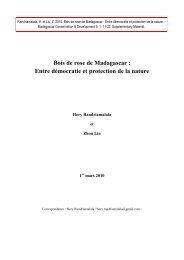Journal Madagascar Conservation - Madagascar Wildlife ...
Journal Madagascar Conservation - Madagascar Wildlife ...
Journal Madagascar Conservation - Madagascar Wildlife ...
You also want an ePaper? Increase the reach of your titles
YUMPU automatically turns print PDFs into web optimized ePapers that Google loves.
MADAGASCAR CONSERVATION & DEVELOPMENT VOLUME 3 | ISSUE 1 — DECEMBER 2008 PAGE 17<br />
Three flying fox (Pteropodidae: Pteropus rufus)<br />
roosts, three conservation challenges in southeastern<br />
<strong>Madagascar</strong><br />
Volana N. Rahaingodrahety I , Daudet Andriafidison II,III ,<br />
Jonah H. Ratsimbazafy I,IV , Paul A. Racey V and Richard<br />
K. B. Jenkins II,V<br />
ABSTRACT<br />
We visited three roosts of the <strong>Madagascar</strong> flying fox Pteropus<br />
rufus in December 2005 in the Anosy Region. Colony size was 900<br />
at Berenty Private Reserve, 412 at Amborabao and 54 at Sainte<br />
Luce, based on single counts at each site. Hunting at the roost is<br />
prohibited at Berenty but P. rufus is trapped at night in the area<br />
surrounding the reserve, where it feeds on sisal. At Amborabao,<br />
the bats roost in a sacred forest and hunting is forbidden. At<br />
Sainte Luce, the forest is highly degraded and the bats are hunted<br />
frequently, despite efforts to engage the local community in forest<br />
conservation. Questionnaires with people living near the<br />
roosts revealed the flying foxes were regarded as pests of litchis<br />
in Amborabao and Sainte Luce. Berenty is the only site where<br />
tourists are able to observe roosting P. rufus. The role of sacred<br />
forests and local taboos (fady) is very relevant for P. rufus conservation<br />
and might be the only practical mechanism in sites where<br />
legislation on hunting and land use is not being enforced.<br />
RÉSUMÉ<br />
Trois gîtes de Pteropus rufus ont été visités dans la région<br />
Anosy en décembre 2005. La population était composée de<br />
900 individus à Berenty, 412 à Amborabao et 54 à Sainte Luce,<br />
le comptage ayant été fait une seule fois dans chaque gîte.<br />
La chasse au dortoir est interdite à Berenty mais P. rufus est<br />
capturé la nuit, lorsque les individus se nourrissent dans les<br />
plantations de sisal environnantes. A Amborabao, le dortoir se<br />
trouve dans une forêt sacrée où la chasse est interdite. A Sainte<br />
Luce, la forêt est extrêmement dégradée et les chauves - souris<br />
sont chassées fréquemment malgré les efforts pour impliquer la<br />
communauté locale dans la conservation de la forêt. Les interviews<br />
avec les gens vivant près des dortoirs ont montré que les<br />
P. rufus sont considérés comme nuisibles car consommateurs<br />
de fruits de litchis à Amborabao et Sainte Luce. Berenty est le<br />
seul site où les touristes peuvent observer P. rufus au dortoir.<br />
Les forêts sacrées, les croyances locales et les tabous (fady)<br />
sont importants pour la conservation de P. rufus et pourraient<br />
être les seuls facteurs pour expliquer le respect des régulations<br />
cynégétiques et foncières.<br />
Correspondence:<br />
Richard K.B. Jenkins<br />
Madagasikara Voakajy, B.P. 5181<br />
Antananarivo (101), <strong>Madagascar</strong><br />
E-mail: jenkins@moov.mg<br />
KEYWORDS: <strong>Madagascar</strong>, Pteropus rufus, roost, Tolagnaro<br />
INTRODUCTION<br />
The conservation of the <strong>Madagascar</strong> flying fox Pteropus rufus<br />
poses a major challenge because even though it is a threatened<br />
species (IUCN 2007) it is not fully protected by Malagasy law<br />
and can be legally hunted by people for food between May and<br />
September (Durbin 2007, MacKinnon et al. 2003, Racey et al. in<br />
press). In practice however, people either deliberately ignore or<br />
are unaware of the hunting season and P. rufus is widely exploited<br />
throughout the year and this is believed to be causing some colonies<br />
to abandon traditional roosts (MacKinnon et al. 2003, Racey<br />
et al. in press). Roosting and foraging sites are also threatened<br />
by the degradation of native forests, a situation exacerbated by<br />
the tendency for P. rufus to use small forest patches outside of<br />
protected areas (Jenkins et al. 2007ab, Racey et al. in press).<br />
Colonies of up to 5,000 P. rufus have been recorded in<br />
<strong>Madagascar</strong> (MacKinnon et al. 2003) and roosts are attractive to<br />
hunters because of the concentration of bats. However, roosts<br />
should also be important conservation sites for bats in <strong>Madagascar</strong><br />
because they present a viable focus for monitoring and<br />
protection (Goodman et al. 2005).<br />
Previous studies on the ecology of P. rufus in the Anosy<br />
Region have demonstrated that it has a varied diet that includes<br />
exotic plants and that it plays an important role in seed dispersal<br />
(Bollen and van Elsacker 2002, Raheriarisena 2005, Long<br />
and Racey 2007). As part of a regional programme to assess<br />
the status of flying fox colonies (Jenkins et al. 2007b) and to<br />
determine the local anthropogenic factors that influence the<br />
conservation of roosts we made a rapid survey of three sites.<br />
STUDY SITE Roosts were surveyed at Berenty Private<br />
Reserve (referred to as Berenty hereafter), Amborabao<br />
and Sainte Luce over a three - week period during December<br />
2005 (Figure 1). Berenty (Malaza forest S25°00’, E46°18’), 85 km<br />
west of Tolagnaro, is a ca. 200 ha fragment of gallery forest on<br />
the Mandrare River and is a major tourist attraction because<br />
of its tame lemurs. The roost at Amborabao (Mahanoro Forest<br />
S24°49’, E47°02’), 27 km northeast of Tolagnaro, is in a small<br />
I Département des Eaux et Forêt, Ecole Supérieure des Sciences Agronomiques, Université d’Antananarivo, B.P. 175, Antananarivo (101), <strong>Madagascar</strong><br />
II Madagasikara Voakajy, B. P. 5181, Antananarivo (101), <strong>Madagascar</strong><br />
III Département de Biologie Animale, Faculté des Sciences, Université d’Antananarivo, B.P. 906, Antananarivo (101), <strong>Madagascar</strong>.<br />
IV Durrell <strong>Wildlife</strong> <strong>Conservation</strong> Trust, B. P. 8511, Antananarivo (101), <strong>Madagascar</strong><br />
V School of Biological Sciences, University of Aberdeen, Aberdeen, AB24 2TZ, UK



